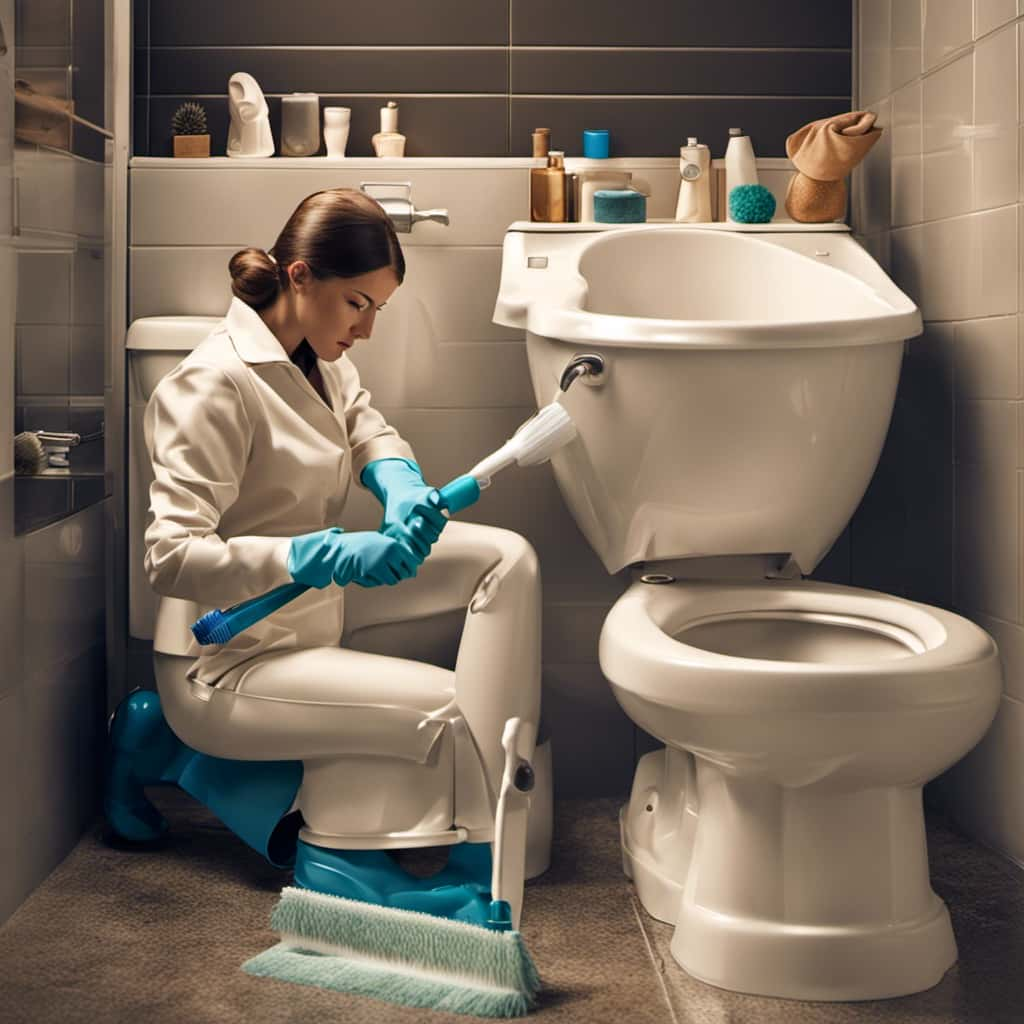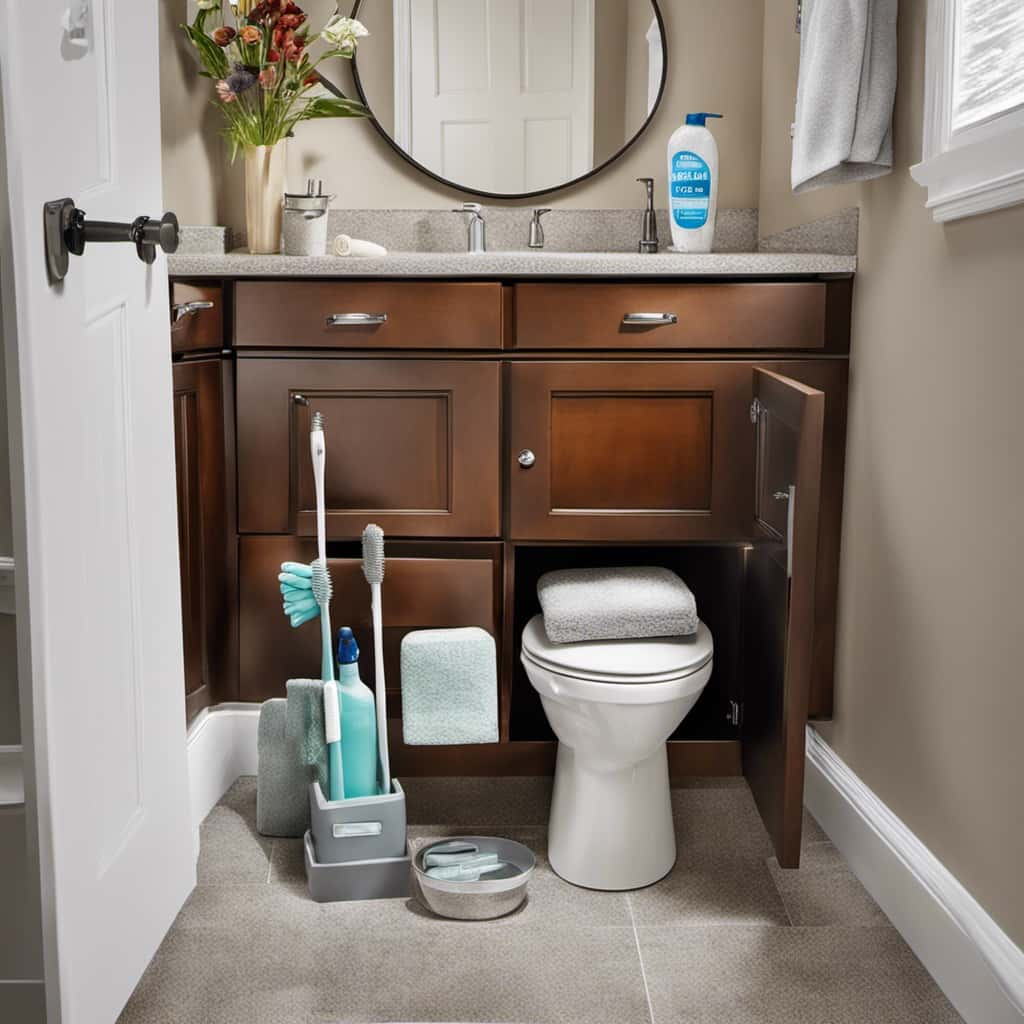Are you curious about whether it’s okay to dispose of sand by flushing it down your toilet? Let’s delve into the consequences for the environment, the hazards it poses to your plumbing, and the possible harm to sewage systems.
We’ll also discuss the alternatives for proper sand disposal, so you can make an informed decision.
Together, we’ll analyze the technical aspects and offer solution-oriented approaches to ensure mastery over this issue.
So, grab your thinking caps and let’s get started!

Key Takeaways
- Flushing sand down the toilet can lead to environmental impact and water contamination.
- It can cause blockages and damage to plumbing systems, increasing maintenance costs.
- Sand in the sewage system can cause blockages, clog pipes, and lead to costly repairs.
- Proper sand disposal alternatives include designated collection sites, recycling, reclamation, and landfill disposal.
Environmental Impact of Flushing Sand
The flushing of sand down the toilet has a significant environmental impact. Sand pollution and water contamination are the key concerns associated with this practice.
When sand is flushed down the toilet, it can enter the wastewater system and ultimately end up in our water bodies. This can lead to a range of negative consequences, including the disruption of aquatic ecosystems and the contamination of drinking water sources.
Sand particles can clog pipes and filters, causing operational issues and increasing maintenance costs for wastewater treatment plants.
To mitigate these problems, it’s important to educate the public about the proper disposal of sand and provide alternative options such as recycling or using sand for landscaping purposes. Additionally, implementing stricter regulations and fines for improper disposal can help deter individuals from flushing sand down the toilet, thereby reducing its environmental impact.

Risks to Plumbing System
Flushing sand down the toilet poses risks to our plumbing system as it can cause blockages and damage to pipes. Here are three reasons why it’s important to avoid flushing sand down the toilet:
- Risks to Pipes: The abrasive nature of sand can lead to the erosion of pipes over time. This erosion weakens the integrity of the pipes and increases the chances of leaks or bursts.
- Clogging Toilets: Sand particles can easily accumulate in the plumbing system, leading to clogs in toilets and other drains. These clogs can be difficult to remove and may require professional assistance.
- Increased Maintenance Costs: Flushing sand down the toilet can result in frequent plumbing issues, leading to higher maintenance costs. Repairing or replacing damaged pipes and clearing clogs can be expensive and time-consuming.
Considering these risks, it’s crucial to avoid flushing sand down the toilet to maintain the proper functioning of our plumbing system.
Moving forward, we’ll discuss the potential damage that flushing sand can cause to sewage infrastructure.
Potential Damage to Sewage Infrastructure
We need to recognize the potential for significant damage to our sewage infrastructure when sand is flushed down the toilet.

The presence of sand in the sewage system can cause blockages and clog pipes, leading to costly repairs and maintenance requirements. Sand particles can accumulate and form obstructions in the pipes, reducing the flow capacity and increasing the risk of sewage backups.
These backups can result in overflows, causing damage to the infrastructure and potential contamination of the environment. To prevent such issues, it’s crucial to educate individuals about the proper disposal of sand and other non-biodegradable materials. Implementing stricter regulations and penalties for improper disposal can help deter individuals from flushing sand down the toilet.
Additionally, conducting regular inspections and maintenance of the sewage infrastructure can help identify and address any potential issues before they escalate, reducing the potential cost and maintenance requirements associated with sand flushing.
Alternatives for Proper Sand Disposal
One possible solution for proper sand disposal is to utilize designated collection sites. These sites are specifically designed to handle the disposal of sand and ensure its proper management.

Here are three alternatives for sand disposal:
- Sand recycling: Sand can be recycled by using specialized equipment to remove impurities and contaminants, allowing it to be reused in various applications such as construction or landscaping.
- Sand reclamation: This process involves treating the sand to remove any contaminants and restore its quality. Reclaimed sand can then be used in foundries or other industrial applications.
- Landfill disposal: In cases where sand can’t be recycled or reclaimed, it can be disposed of in landfills that are designed to handle inert materials like sand.
Conclusion: Making an Informed Decision
To make an informed decision, it is important for individuals to consider the alternatives mentioned earlier for proper sand disposal. Weighing the pros and cons and considering the long-term effects are crucial steps in making a responsible choice. To help you evaluate the options, we have prepared the following table:
| Alternative | Pros | Cons |
|---|---|---|
| Proper disposal | Environmentally friendly | Requires effort and time |
| Landfill | Convenient | Limited capacity |
| Reuse or recycle | Reduces waste | Limited applications |
| Composting | Fertilizes soil | Requires specific setup |
| Professional services | Expert handling and disposal | Costly |
Frequently Asked Questions
Can Flushing Sand Down the Toilet Cause Harm to Marine Life?
Flushing sand down the toilet can have harmful effects on water quality and pose a significant impact on coral reefs. It is important to consider alternative disposal methods to protect marine life and maintain the health of our ecosystems.
What Are the Long-Term Effects of Flushing Sand on the Environment?
Flushing sand down the toilet has grave long-term effects on the environment. It contributes to the ecological impact of sand mining and threatens natural habitats. Proper waste disposal is crucial for preserving our ecosystems.

Will Flushing Sand Down the Toilet Lead to Clogged Pipes and Plumbing Issues?
Flushing sand down the toilet can lead to clogged pipes and plumbing issues. The sand particles can accumulate, obstructing the flow of water and causing blockages. It is not recommended to flush sand down the toilet.
How Can Flushing Sand Down the Toilet Affect Sewage Treatment Plants?
Flushing sand down the toilet can have a negative effect on water quality and disrupt wastewater treatment processes. It can clog pipes, damage equipment, and hinder the proper treatment of sewage in treatment plants.
Are There Any Eco-Friendly Alternatives for Disposing of Sand Properly?
When it comes to eco-friendly sand disposal, we must consider sustainable sand management. Are there any alternatives for disposing of sand properly? Let’s explore solutions that prioritize the environment and ensure efficient waste management.
Conclusion
In conclusion, it isn’t advisable to flush sand down the toilet due to its negative environmental impact and potential risks to the plumbing system and sewage infrastructure.

Instead, it’s important to explore alternative methods for proper sand disposal, such as utilizing sand collection bins or contacting local waste management authorities for guidance.
Making an informed decision regarding sand disposal can help protect the environment and maintain the functionality of our plumbing and sewage systems, preventing any sand-related mishaps from occurring.










